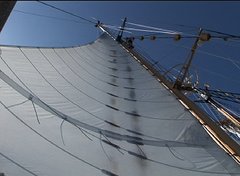 Rangiroa and the French Overseas Territory of Polynesia are now well off our stern as we sail east northeast towards the Republic of Kiribati. Today we are getting into the rhythms of work and life during a long blue water passage. But we are also reflecting on our time together in the Tuamotu chain of seamounts and islands. Rangiroa was a wonderful stop for all aboard. We started our coral reef projects with teams studying parrot fish interactions with coral and algae as well fish biomass. With the help of locally-leased speed boats driven by wild French drivers we surveyed several widely separated reefs within the world’s second largest atoll, including a stunning little motu (islet) sitting all by itself in the center of the lagoon. One of the very best reefs is known as “The Aquarium” and was a 5 minute small boat ride from the Robert C Seamans anchor site. Nearly everyone on the ship had a chance to spend an hour or two in the company of Picasso Triggerfish, Flutefish, Banded Sargent Majors, and many more spectacularly colored “Poisson de Tahiti”. A few blacktip reef sharks cruised by, but their bellies were full and they had no interest in us gangly creatures from the land.
Rangiroa and the French Overseas Territory of Polynesia are now well off our stern as we sail east northeast towards the Republic of Kiribati. Today we are getting into the rhythms of work and life during a long blue water passage. But we are also reflecting on our time together in the Tuamotu chain of seamounts and islands. Rangiroa was a wonderful stop for all aboard. We started our coral reef projects with teams studying parrot fish interactions with coral and algae as well fish biomass. With the help of locally-leased speed boats driven by wild French drivers we surveyed several widely separated reefs within the world’s second largest atoll, including a stunning little motu (islet) sitting all by itself in the center of the lagoon. One of the very best reefs is known as “The Aquarium” and was a 5 minute small boat ride from the Robert C Seamans anchor site. Nearly everyone on the ship had a chance to spend an hour or two in the company of Picasso Triggerfish, Flutefish, Banded Sargent Majors, and many more spectacularly colored “Poisson de Tahiti”. A few blacktip reef sharks cruised by, but their bellies were full and they had no interest in us gangly creatures from the land.Those going ashore were treated to the sights and sounds of a sleepy Polynesian village full of coconut palms and fruit trees. The French influence is strong here – even at the edges of civilization one can find baguettes and good coffee. Rangiroa even boasts a vineyard and winery – unusual for a hot tropical isle and we were told the product suffered some deficiencies. A number of students and staff woke early Sunday morning for the board ride to the village of Tipatu where they attended a church service given in Polynesian. On Monday, May 11th, we terminated scientific missions and shore leave at 1100 to prepare for clearing immigrations and customs out of French Polynesia. After all aboard were seen by the authorities, passports were stamped, and the ship was prepared for sea. Leaving Rangiroa can be tricky. The main navigable channel connects a very large lagoon to the open sea. Tidal currents regularly exceed 6 knots in the channel, producing 5 foot standing waves and massive whirlpools. For our departure, we balanced a waning ebb tidal bore against the onset of dusk. At 1735L, with Stanford@SEA students at the helm, Captain Pamela safely guided the Robert C Seamans out of the lagoon and into deep waters north of Rangiroa.
Winds are light and sea is glassy as we sail towards Kiribati. All aboard seem to have acquired their sea legs and appetites for the fabulous food prepared by chef Vicky. Everyone aboard is safe, healthy, and happy and we send all you landlubbers our fondest regards.




6 comments:
Loving the blogs, guys! Keep it up. Thanks for the Mother's Day wishes (and card, Isa!). We are living vicariously and thrilled to follow your adventures.
The Bellinger-Badía-Balzer crowd!
Wow, those waters look breathtakingly beautiful!
Thanks for the colorful and mouth watering blog posts - but could you please include the names of the authors? We'd love to get to know everyone better through their writing.
Wishing you all more smooth sailing!
Thanks for the blogs and pictures. Great to hear that about your successful progress and amazing experiences. Fair winds!
We're loving these blogs and photos and so thankful that it's been smooth sailing thus far. Keep up the wonderful communications :) We miss you Em, but are so thrilled that you and your mates are having this extraordinary journey.
xo
the Hutchinsons
I am enjoying the posts, but several of them are not signed! Please include your name at the end of your blog entry.
Joe Wible
We are very excited to see one of our New England Aquarium Teen Alumni, Dilly, scientifically exploring Kiribati- especially since ongoing research in The Phoenix Islands Protected Area is so important to us! Go Dilly!
Post a Comment